Centauri Dreams
Imagining and Planning Interstellar Exploration
Looking Back at the Spitzer Space Telescope
The Spitzer Space Telescope, which is to end its mission on January 30, has a special place in my memory. I was making a trip to the Jet Propulsion Laboratory as part of the research for my Centauri Dreams book when I noticed on a monitor a countdown — still in days — for the launch of Spitzer, then known as the Space Infrared Telescope Facility (SIRTF).
The observatory was launched on the 25th of August, 2003. I remember hot Pasadena weather, a conversation with aerospace legend Adrian Hooke (he was a member of the Kennedy Space Center launch team for Apollo 9, 10, 11 and 12, among much else), a rousing talk with Humphrey “Hoppy” Price about interstellar possibilities. So many good conversations, some serious interviews, and a growing enthusiasm for interstellar flight.
But Spitzer had my attention because it was the next mission, one of the Great Observatory missions which included the Hubble Space Telescope, the Compton Gamma Ray Observatory, the Chandra X-ray Observatory, and Spitzer itself. The infrared observatory lasted longer than anyone expected and continued to function even after exhausting its helium coolant in 2009, at which point the ‘cold mission’ ended, but the ‘warm mission’ would last over a decade.
‘Warm’ and ‘cold’ are obviously relative terms when we talk about objects in space. With a full stock of coolant, the spacecraft could maintain temperatures as low as minus 267 degrees Celsius, so yes, that’s ‘cold.’ But Spitzer functioned a long way from Earth, so that even the ‘warm’ mission could operate at minus 244° C, and that enabled continued observations in two infrared wavelengths. We got more than 16 years of use out of Spitzer, another case among many of a mission’s science team working all the angles to keep their craft alive.
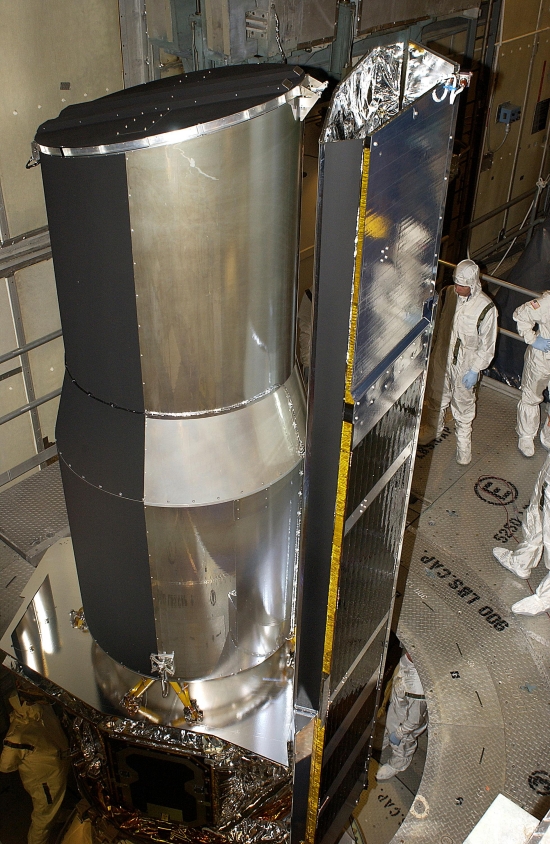
Image: The Spitzer Space Telescope (formerly the Space Infrared Telescope Facility or SIRTF) is readied for launch at Cape Canaveral Air Force Station, in 2003. Credit: NASA.
The beauty of working at infrared wavelengths is that you can see things that are too cold to emit much visible light. For our purposes, that includes brown dwarfs and exoplanets, but the observatory has also excelled at studying distant galaxies, including (in conjunction with Hubble observations) the most distant galaxy yet observed, GN-z11, which is seen in the direction of Ursa Major as it was 13.4 billion years in the past. Again of direct relevance to Centauri Dreams readers is Spitzer’s work on interstellar dust, whose chemical composition, studied via spectroscopy, can help us learn more about what goes into planet formation.
This is the instrument that, in 2007, gave us the first identification of molecules in the atmosphere of an exoplanet — two of them, actually. HD 209458b and HD 189733b are ‘hot Jupiters’ and the use of transmission spectroscopy to study their atmospheres points us toward the future prospect of searching for biosignatures on small, rocky planets like Earth. In 2010, Spitzer was part of the discovery of a planet 13,000 light years away, found via gravitational microlensing. Back in 2005, it made direct observations of the ‘hot Jupiters’ HD 209458b and TrES-r1, the first telescope to directly observe light from a planet in another stellar system.
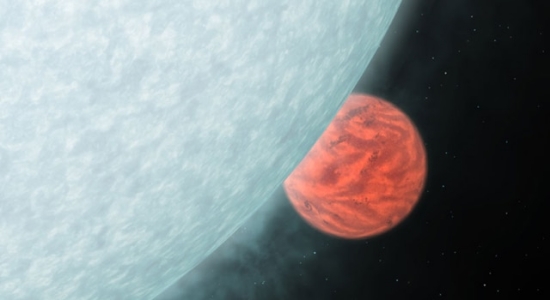
Image: Spitzer was the first telescope to directly observe light from a planet outside our solar system. Prior to that, exoplanets had been observed only indirectly. This accomplishment kicked off a new era in exoplanet science, and marked a major milestone on the journey toward detecting possible signs of life on rocky exoplanets. Two studies released in 2005 reported direct observations of the warm infrared glows from two previously detected “hot Jupiter” planets, designated HD 209458b and TrES-r1. Hot Jupiters are gas giants similar to Jupiter or Saturn, but are positioned extremely close to their parent stars. From their toasty orbits, they soak up ample starlight and shine brightly in infrared wavelengths. Credit: NASA/JPL-Caltech.
I won’t even try to go through all of Spitzer’s accomplishments, but I do need to mention the seven Earth-sized planets around TRAPPIST-1, which Spitzer data, over 500 hours worth, helped scientists identify via transit methods. And I have to include the ‘weather map’ of HD 189733b, a chart of temperature variations over the surface of a gas giant. Sean Carey, manager of the Spitzer Science Center at Caltech, has this to say about the instrument:
“When Spitzer was being designed, scientists had not yet found a single transiting exoplanet, and by the time Spitzer launched, we still knew about only a handful. The fact that Spitzer became such a powerful exoplanet tool, when that wasn’t something the original planners could have possibly prepared for, is really profound. And we generated some results that absolutely knocked our socks off.”
So true! From its Earth-trailing orbit, Spitzer was a long way from our planet’s heat and could offer greater sensitivity than other instruments, especially considering that it could detect some infrared wavelengths that could not be seen through the filter of our atmosphere. What a marvelous run for this observatory, whose decommissioning leads us directly into the launch of the infrared James Webb Space Telescope. We can only hope that the highly complex JWST makes it safely into space and that it lives to see as many mission extensions (5) as the Spitzer Space Telescope.
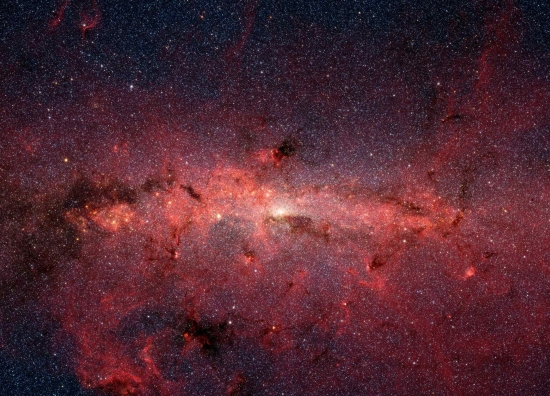
Image: This dazzling infrared image from NASA’s Spitzer Space Telescope shows hundreds of thousands of stars crowded into the swirling core of our spiral Milky Way galaxy. In visible-light pictures, this region cannot be seen at all because dust lying between Earth and the galactic center blocks our view. In this false-color picture, old and cool stars are blue, while dust features lit up by blazing hot, massive stars are shown in a reddish hue. Both bright and dark filamentary clouds can be seen, many of which harbor stellar nurseries. The plane of the Milky Way’s flat disk is apparent as the main, horizontal band of clouds. The brightest white spot in the middle is the very center of the galaxy, which also marks the site of a supermassive black hole. Credit: NASA/JPL-Caltech.
Spitzer was a pathfinder in many areas of astronomical research, but a kind of personal pathfinder for me, as I’ve always associated its observations with my work as a chronicler of this field. An observatory designed to study “the cold, the old and the dusty,” as NASA likes to say, taught us about objects as close as nearby asteroids and as far as the oldest galaxies. The frustrations of human spaceflight in the post-Apollo era have to be balanced against the brilliance of science missions like Spitzer, which have charted a path forward that should one day lead to direct observations of planets where life may even now be flourishing.

An Impact-Driven End to ‘Snowball Earth’?
The oldest preserved impact structure on Earth appears to be at Yarrabubba in Western Australia, where a magnetic anomaly about 20 kilometers in diameter has been interpreted to be a remnant of an original impact crater 70 kilometers across. Here, what had been an approximate age of 2.65 to 1.075 billion years has now been constrained to 2.229 billion years, making Yarrabubba 200 million years older than the next oldest impact.
A team led by Timmons Erickson (Curtin University) analyzed the minerals zircon and monazite at the site. Their sample showed shock recrystallization (in the form of so-called neoblasts) from an asteroid strike, the analysis of which allowed them to pin down the structure’s age. A paper just out in Nature Communications reports on the team’s use of uranium-lead (U–Pb) dating to investigate the age of the shock features and impact melt.
A global climate change may have occurred as a result of this impact, perhaps one with consequences for so-called ‘snowball Earth,’ a hypothesis of almost planet-wide ice cover in one or more periods before 650 million years ago. This impact conceivably ended the ice era.
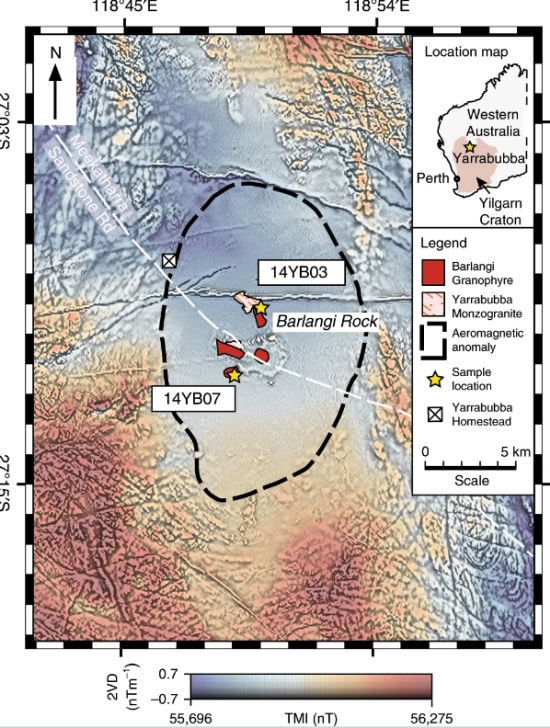
Image: This is Figure 1 from the paper. Caption: Composite aeromagnetic anomaly map of the Yarrabubba impact structure within the Yilgarn Craton, Western Australia, showing the locations of key outcrops and samples used in this study. The image combines the total magnetic intensity (TMI, cool to warm colours) with the second vertical derivative of the total magnetic intensity (2VD, greyscale) data. The demagnetised anomaly centred on the outcrops of the Barlangi granophyre is considered to be the eroded remnant of the central uplift domain, which forms the basis of the crater diameter of 70?km. Prominent, narrow linear anomalies that cross-cut the demagnetised zone with broadly east-west orientations are mafic dykes that post-date the impact structure. Credit: Erickson et al.
The result is intriguing because the Yarrabubba crater was made at a time when rocks on many continents provide evidence of glacial conditions, and oceans were becoming more oxygenated. Thus co-author Nicholas Timms (Curtin University):
“The age of the Yarrabubba impact matches the demise of a series of ancient glaciations. After the impact, glacial deposits are absent in the rock record for 400 million years. This twist of fate suggests that the large meteorite impact may have influenced global climate.
“Numerical modelling further supports the connection between the effects of large impacts into ice and global climate change. Calculations indicated that an impact into an ice-covered continent could have sent half a trillion tons of water vapour – an important greenhouse gas – into the atmosphere. This finding raises the question whether this impact may have tipped the scales enough to end glacial conditions.”
An end to a period of snowball Earth? Perhaps so. Certainly the work is a reminder of how much we have to learn about crater structures on our own planet, and how much we need to acquire precise ages for them. The impact’s effects, assuming a continental ice sheet, would have been powerful. The team’s numerical models of a 70-kilometer impact crater driven into a granitic target with overlying ice sheet (modeled at from 2 to 5 kilometers in thickness) show the almost instantaneous vaporization of huge amounts of ice. From the paper:
The vapourised ice corresponds to between 9?×?1013 and 2?×?1014?kg of water vapour being jetted into the upper atmosphere within moments of the impact… Impact-generated water vapour in the lower atmosphere would have condensed and rapidly precipitated as rain and snow with no significant long-term climate effects, or could have even triggered widespread glacial conditions via cloud albedo effects during interglacial periods. However, ejection of high-altitude water vapour has potential for greenhouse radiative forcing, depending critically on atmospheric residence time.

Image: Zircon crystal used to date the Yarrabubba impact. Credit: Erickson et al.
The authors are quick to note how difficult it is to model the impact’s effects due to our uncertainties about the composition of the Earth’s atmosphere in the period in question. But they note that the atmosphere would have contained only a fraction of current levels of oxygen, making it likely that huge amounts of H2O vapor released instantaneously into the atmosphere would have had global ramifications.
While the ‘snowball Earth’ hypothesis dominates coverage of this paper, I think the broader significance is in the nature of ongoing research. We can inspect the impact record on surfaces like the Moon due to the lack of atmospheric erosion, but on Earth we face the latter as well as the obscuring effects of tectonics. Until we have a better record of terrestrial impacts, we won’t understand the links between impacts and changes to global climate. At least we have the notable exception of the Chicxulub crater in the Gulf of Mexico’s Yucatán Peninsula, a feature under intense study.
Going back much farther in time, however, we’re looking at poorly constrained and ambiguous impact evidence, a problem that this paper addresses for a period that was hitherto lacking in impact analysis at this level of detail. More broadly, we’re reminded as well of the shaping effect of bombardment as young terrestrial planets evolve, and should always be mindful of the contingencies forced upon nascent worlds by system debris.
The paper is Erickson et al., “Precise radiometric age establishes Yarrabubba, Western Australia, as Earth’s oldest recognised meteorite impact structure,” Nature Communications 11, article no: 300, published online 21 January 2020. Full text.

A Deep Dive into Tidal Lock
Mention red dwarf habitable zones and tidal lock invariably comes up. If a planet is close enough to a dim red star to maintain temperatures suitable for life, wouldn’t it keep one face turned toward it in perpetuity? But tidal lock, as Ashley Baldwin explains in the essay below, is more complex than we sometimes realize. And while there are ways to produce temperate climate models for such planets, tidal lock itself is a factor in not just M-dwarfs, but K- and even G-class stars like the Sun. Flip a few starting conditions and Earth itself might have been in tidal lock. The indefatigable Dr. Baldwin keeps a close eye on the latest exoplanet research, somehow balancing his astronomical scholarship with a career as consultant psychiatrist at the 5 Boroughs Partnership NHS Trust (Warrington, UK). Read on to learn a great deal about where current thinking stands on a subject critical to the question of red dwarf habitability.
by Ashley Baldwin

“Tidal locking”, “captured rotation” or “spin-orbit locking” etc occurs in most recognised guise when an orbiting astronomical body (be it a moon, planet or even a star) always presents the same face towards the object it is orbiting. In this instance, the orbit of the “satellite” body can be referred to as “synchronous”, whereby the tidally locked body takes as long to rotate around its own axis as to orbit its partner. This occurs due to the primary body’s gravity flexing the orbiting body into an elongated “prolate” shape. This in turn is then exposed to varying gravitational interaction with the central body.
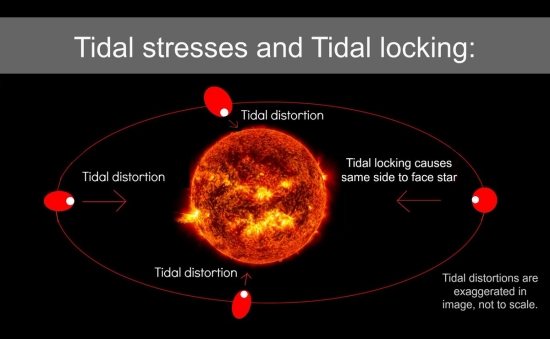
Figure 1: Tidal stresses and tidal locking
As the “orbiter” rotates, its now elongated axis falls out of line with the central mass, which consequently perturbs it as it rotates across its orbit. It thus becomes subject to gravitationally induced torques that can act as a brake — through energy exchange and dissipation, the latter via friction-induced heat loss in the perturbed orbiting body. As M dwarf habitable zones are closer to their central star and their gravitational influence thus greater, it’s easy to see how this dissipated heat can contribute substantially to an exoplanet’s overall energy flux and can even affect its habitability potential – possibly tipping it into a runaway greenhouse scenario. (Kopparapu 2013).
Over millions of years (or more) this process can lead to “orbital synchronisation”. This arises when the orbiting body reaches a state where there is no longer any net exchange of rotation during the course of a completed orbit (Barnes 2010). Leaving a tidal locking state would only be possible with the addition of energy to the system. This might occur should some other massive object (such as a planet, or a star in, say, a binary system) break the equilibrium. If the masses of the two bodies (for instance Pluto & Charon) are similar, they can become tidally locked to each other.
Not all tidal locking involves synchronisation. “Super-synchronisation” occurs where an orbiting body becomes tidally locked to its parent body but rotates at a fixed but quicker rate. A topical example of this is the erstwhile “geosynchronous transfer orbit” (GTO). We see this on launcher specs all the time: “Payload to GTO”. This orbit is external to geosynchronous orbit, where many satellites start their operational lives, but allows for pre-orbital insertion inclination changes — economically expending less propellant prior to final insertion. Alternatively, such orbits can be used as dumping grounds for non-functioning satellites or related debris, so-called “geo-graveyard belts” (Luu 1998). Simulations suggest many exoplanets could exist in variants of such orbital types.
Gravitational interaction with a central star leads to progressive rotational slowing of a smaller planetary body like Mercury via energy exchange and heat dissipation. This is due to subtle but important tidal force variations across the orbiting body (remembering that gravity is inversely proportional to the square of the distance between any two bodies — thus “gravitational gradients” exist across solid bodies, leading to bulges). However, if the initial planetary orbit is significantly eccentric, this effect varies substantially across the orbital period (especially at periapsis — the point of strongest gravitational interaction) and can instead result in a spin-orbit resonance. In Mercury’s case, this is 3:2 (three rotations per two orbits) but other ratios can occur from 2:1 through 5:2 (Mahoney 2013). It’s worth noting that this effect is most pronounced for closer-in planets where the gravitational effects are greatest, so the effect should be even more relevant for the tightly packed exoplanetary architectures (e.g. TRAPPIST-1) that seem to be prevalent.
In extreme cases where the orbiting body’s orbit is nearly circular AND has a minimal or zero axial tilt — such as with the Moon — then the same hemisphere (libration allowing) faces the primary mass.
That said, for simplicity we will now assume that a smaller mass body (exoplanet) is orbiting a very much more massive body (star) — this is the focus of this review, with an unavoidable nod towards habitability.
For reasons of brevity and also pertaining to the exoplanet subject matter of recent posts, we will limit ourselves to the specific case of terrestrial exoplanets and their orbits around smaller main sequence stars.
The time to tidal locking can even be described by the adapted equation :
Tlock ≈ wa6 (0.4 m*R2) / (3 Gmp2 kR5) (Goldreich, Goldreich & Soter 1966); (Peale 1977); (Gladman 1996); (Greenberg 2009)
Where Tlock is “time to tidal locking”, w and k are constants which can be ignored for simplicity, m* is mass of the star, mp is mass of the planet, R is the exoplanet radius and “G” is Newton’s all important gravitational constant.
Tlock is substantially lengthened by “a” — increasing planetary semi-major axis (to the sixth power!). Tidal locking time is also increased by 0.4 X m* in this equation. However it is important to remember the context and just how massive a star, indeed ANY star, is — even an M dwarf star — many times, orders of magnitude even, more massive than a planet. A star thus plays the major role in the tidal locking of its attendant planets.
The gravitational constant G ensures that increasing stellar mass will substantially decrease Tlock. All other things being equal, increasing stellar mass is a major factor in reducing time to tidal locking.
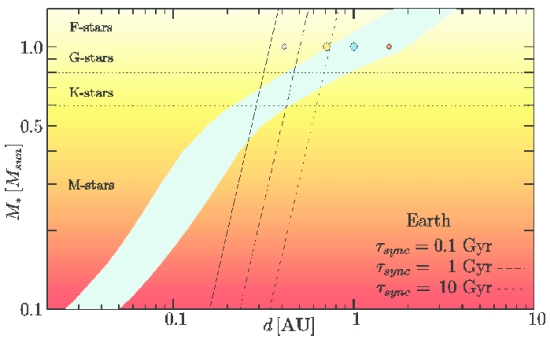
Figure 2: Stellar mass & type versus semi-major axis orange / red graph with superimposed Tsync for 0.1,1 and 10 gigayear times for an Earth mass planet. (Penz 2005)
The concept of synchronisation is relatively new, dating back to Stephen Dole’s seminal Habitable Planets for Man at the beginning of the space age in the early 1960s. The concept was purely theoretical, with somewhat arbitrary parameters at this point, but it implied that tidal lock would be a major impediment to the human-friendly “habitable” exoplanets Dole had in mind for his book. It was here that tidally locked orbits and planets in M-dwarf systems were first linked, in a negative way that to some extent still exists today (before we even get to coronal mass ejections, EUV and stellar flares et al !) Atmospheric collapse due to freezing out on the side of the planet facing away from the star is not the least of these problems.
It was only in 1993 that Kasting et al employed sophisticated 1-D climate modelling as part of describing what constituted habitable planets. Habitable planets essentially now meant planets with conditions that could sustain liquid water on their surfaces. This is a rather lower bar than that set by Dole thirty years earlier, but far more applicable and still a pillar of exoplanet science today. More importantly, Kasting’s team also simulated star/planet gravitational interaction.
They did this by utilising the “Equilibrium Tide” model (ET). Refined variants of this have now become THE staple of all subsequent related studies, as it too has “evolved”. The model essentially assumes that the gravitational force of the tide-raiser (star) produces an elongated shape in the perturbed body (exoplanet) and that its long axis is slightly misaligned with respect to an imaginary line connecting the two centres of mass.
The misalignment is crucial and is due to the dissipating processes within the “deformed” exoplanet, leading to evolution of the orbit and spin angular moments. From this, various equations can be created which map out the orbital and rotational evolutionary history of exoplanets over time (see above). ET was originally derived from the Earth/Moon system by Darwin in 1880 before refinement by Pearle in 1977. Iterations vary in subtle but significant ways and are used as the basis for increasingly sophisticated simulations as computing power increases. Barnes 2017 has carried out a detailed review of synchronising and ET modelling (see below).
Kasting et al showed synchronisation of putative exoplanets orbiting in the habitable zones of M-dwarfs, stars with a mass of up to 0.42 Msun, within 4.5 billion years. They introduced the now familiar term “tidal locking radius”. Though a big step forward, this had the unfortunate consequence of continuing to propagate a pessimistic view of habitable exoplanets orbiting such stars. Importantly, stellar mass was still viewed as the major if not sole cause of synchronisation. The graph below (from Yang et al 2014), though based on sophisticated modelling, still captures this type of thinking. Here various habitable zone model ranges are superimposed on a graph of relative stellar insolation (and star type) versus semi-major axis examples of known exoplanets, adding realistic perspective. You will note also that for a 0.42 Msun star, with a temperature around 3500 K, the 1-D inner habitable range is very close to the value attributed to recently discovered TOI 700d — mid-80s percent.
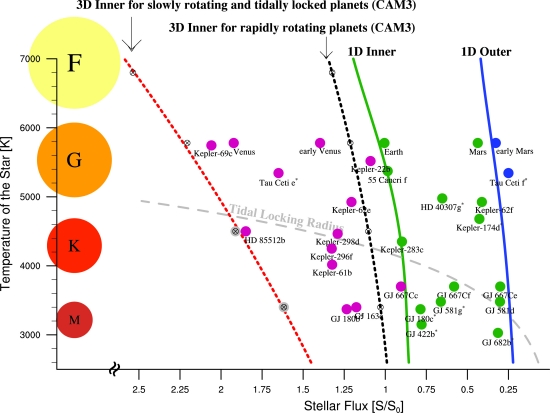
Figure 3: Temperature of star versus stellar flux graph with superimposed coloured star classes and dashed gray “tidal locking radius” line.
The effects of other factors — such as starting orbital eccentricity (already encountered above with Mercury), baseline rotation rate, the presence of companion bodies (Greenberg, Corriea 2013) thermal tides arising from atmospheres (Leconte et al 2015), and stellar and planetary interiors (Driscoll & Barnes 2015), orbital tilt (Barnes 2017) — were not considered. As can be seen, it has only been over the last five years or so that these things have been added to simulations. Indeed, the results of these studies very much alter the whole tidal locking paradigm with particular relevance to habitable zones, which despite refinement (Kopparapu 2013, Selsis 2007) have only changed slightly, a big compliment to Kasting’s work in 1993.
Taken altogether, habitable zone planets of M,K and G stars all have the potential to become tidally locked. Not just M dwarfs — though their potential remains very much the greatest and especially for < 0.1 Msun stars such as TRAPPIST-1. Even the Earth, had its starting rotation been greater than just three days, according to Barnes 2017, might have become synchronous.
For the sake of brevity, this review has largely focused on stellar mass as a major driver in exoplanetary synchronisation. As can be seen above, as knowledge in this area progresses, other processes come into account. It is also becoming increasingly difficult to tease these out from drivers of exoplanetary habitability. So to this end we must look in more detail at some of the factors named above.
The planet Venus is unusual in many ways, but one in particular stands out: its retrograde and slow rotation rate that is longer than its orbital period. Why? What makes Venus different? One factor is that it is a rocky planet with a substantial atmosphere (92 bar at its surface). We all know about the infamous runaway greenhouse effect this drives, making Venus the hottest planet in the Solar System despite being further from the Sun than (spin/orbit resonant) Mercury. However, does this atmosphere have any other effects?
On Earth, the day/night cycle leads to variations in heat distribution in the atmosphere. It is known that the hottest time of day on Earth does not occur when the Sun is at its zenith and thus nearest to the Earth, but rather several hours later. This is because of thermal inertia. There is a delay between solar heating and thermal response, leading to mass redistribution. As the atmosphere and the Earth’s surface are generally well linked via friction, this will give rise to non-negligible thermal torques.
These torques are akin to the torques arising from the Sun’s uneven gravitational interaction with the Earth described above, though not as potent. On the Earth with its extended 1 AU orbit, they are largely inconsequential, but for 0.3 AU nearer Venus, they become significant. Depending on their direction, they can either slow up OR speed up planetary rotation, but either way they help to resist synchronisation. Over time, torques arising in Venus have acted to slow down its rotation, so much so that it has reversed to the retrograde pattern we see today.
So if this is true of Venus, how about exoplanets? Can these atmospheric torques resist or at least delay synchronisation and tidal locking in vulnerable areas around a star? This has been extensively modelled by Leconte et al 2015 and the answer was a resounding yes, especially for smaller, less luminous stars with close-in habitable zones, and not just for exoplanets with 90 bar atmospheres, either. Even 1 bar Earth-like atmospheres could help resist synchronisation for the habitable zones in stars of 0.5 Mearth – 0.7 Mearth.
Ten bar atmospheres were simulated and shown to resist synchronisation even for habitable zone planets orbiting 0.3 Mearth stars (mid-M dwarfs). These are the high bar “maximum greenhouse” CO2 atmospheres that are postulated to occur in the outer regions of stellar habitable zones. But there are limits. Venus’ 92 bar atmosphere is ironically so thick that most of the incident sunlight that isn’t reflected back into space is either absorbed or scattered before it can reach the planetary surface and exert the driving effect of thermal torques (Leconte et al 2015).
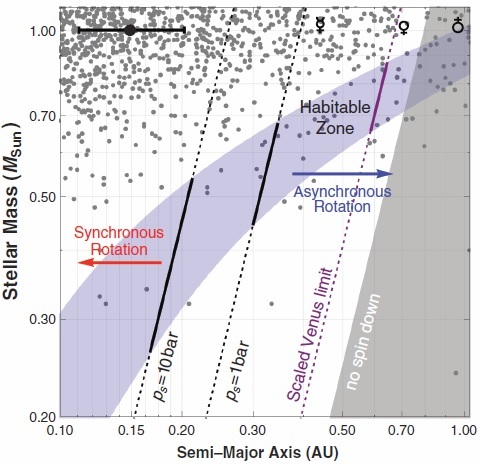
Figure 4: Red arrow synchronous rotation / blue arrow asynchronous rotation graph (Leconte 2015).
Orbital synchronisation and exoplanet habitability remains a contentious theoretical field that is subject to continual debate and constant change. Modern Global Climate Modelling (GCM) has become a sophisticated sub-science. Using an earlier iteration of GCM, Yang et al showed in 2013 that synchronised M-dwarf habitable zone planets would form thick cloud banks above their sub-stellar point. This would then reflect much of the incident stellar flux, thus reducing the energy reaching the surface. In turn, this would reduce the overall energy reaching the planet and so reduce global temperatures. The net effect in theory is to extend the stellar habitable zone inwards. However, the same author collaborated with Wolf and Kopparapu in 2016 to apply an updated 3-D model to the same problem. This showed that a sub-stellar cloud bank could not form, or would form and then move, a result effectively rebutting the 2013 findings and moving the habitable zone back to its original pre 2013 starting point. Expect more of this !
So, all things considered, just how easy is it for an exoplanet to become tidally locked and just how easy can habitable zone planets become tidally locked ? Barnes 2017 attempted to address just this question for exoplanets in circular orbits. He applied two well recognised refined variants (CPL left, CTL right in the graphic below) of the ET to two model populations of exoplanets orbiting differing stellar masses, and ran thousands of giga-year simulations for each (think of the computing power and time!) One population had a starting orbital period of 8 hours and an orbital tilt of 60°. The other had a starting period of ten days and a tilt of 0°. This produced the four outcomes illustrated below. The superimposed grey shading represents the latest habitable zones (Kopparapu 2013) iteration, with the dark grey representing the “conservative” and the light the “optimistic”.
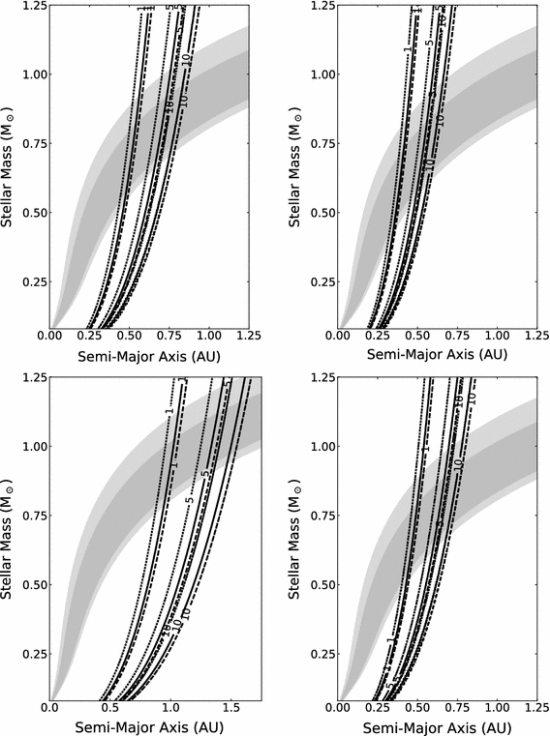
Figure 5: “Four in one” black and white stellar mass vs semi-major axis / superimposed greyscale habzone graphs.
These results are indicative and significantly different from the status quo, which is that tidal locking is only something that applies to exoplanets orbiting in close to M dwarf and smaller K dwarf stars. For one thing, even this older paradigm implies that at least some “Goldilocks” stars are not quite as homely as expected (more Kasting than Dole). The Barnes work hints at potential overlap of the habitable zone for potentially a large fraction of K-class and even many G-class stars, driven by factors beyond simple stellar mass. Clearly planets with a slow initial rotation rate and low orbital tilt are at greater risk, as may prove the case. Opposed to this are non-synchronising factors such as, inter alia, higher baseline orbital eccentricities and the close proximity of other orbiting bodies (moons, planets …thinking TRAPPIST-1 and binary stars/brown dwarfs, as with the recently described Gliese 229Ac system).
What this also shows is the inextricable link between orbital features and planet habitability. No more so demonstrated than by Kepler, and likely even more so with its greater number of short orbital period planets, with any potential habitable zone planetary candidates lying within just tenths or less of an AU from their parent star. This is very much in the “red arrow” synchronous zone in the Leconte graphic above.
There are now over 4000 known exoplanets. The current focus is on their “characterisation” and this is largely about atmospheres and biosignatures. However, it is obvious that we need to know far more about their evolving and historical orbital properties. This is a part of a process of determining habitable planets/zones, which are about so much more than stellar mass.
Most of the exoplanets discovered already by Kepler et al orbit close in to their stars, including those few in the potential tidal lock habitable zone. Ongoing Doppler photometry and TESS will identify thousands more such exoplanets, many of which will be even closer to their latest star given TESS’ shorter 27 day observation runs. TOI 700d and Gliese 229Ac are just for starters. Hopefully the search for habitability will expand to encompass the unavoidable connexion with planetary orbital features.
Know the star to know the planet, but know the orbit to know them both.
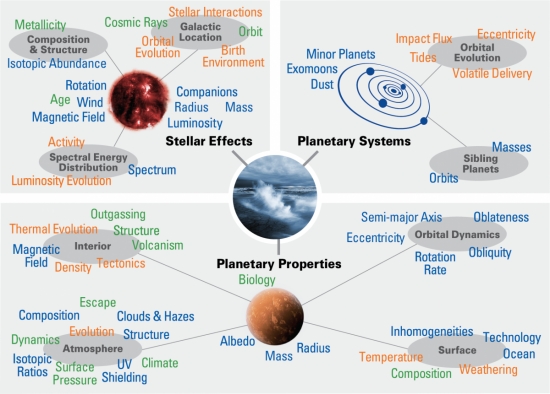
Figure 6: Stellar effects/planetary properties/planetary systems (Meadows and Barnes 2018)
References
Barnes,R. Formation and evolution of exoplanets. John Wiley & Sons, p248, 2010
Barnes, R. Tidal locking of habitable exoplanets. Celestial mechanics and dynamical astronomy Vol 129, Issue 4, pp 509-536, Dec 2017
Darwin, G H. On the secular changes in the elements of the orbit of a satellite revolving about a tidally distorted planet. Royal Society of London Philosophical Transactions, Series I, 171:713-891 ; 1880.
Dole, S H. Habitable Planets for Man. 1964
Goldreich, P. Final spin rates of planets and satellites. Astronomical Journal, 71, 1966
Goldreich, P., Soter, A., Q in the solar system. Icarus 5, 375-389, 1966
Gladman, B et al. Synchronous locking of tidally evolving satellites. Icarus 133 (1) 166-192, 1996
Greenberg, R. Frequency dependence of tidal Q, The Astrophysical Journal, 698, L42-45, 2009
Kasting, J. F. Habitable zones around main sequence stars. Icarus,101 d 108-128 Jan 1993
Kopparapu, R K et al. Habitable zones around main sequence stars: New Estimates. The Astrophysical Journal, 765;131, March 2013
Kopparapu R K, Wolf E, Yang et al. The inner edge of the habitable zone for synchronously rotating planets around low-mass stars using general circulation models. The Astrophysical Journal Volume 819, Number 1, March 2016
Luu, K. Effects of perturbations on space debris in super-synchronous storage orbits. Air Force Research Laboratory Technical Reports, 1998
Mahoney,T J. Mercury. Springer Science & Business Media, 2013
Meadows V S, Barnes R K. Factors affecting exoplanet habitability. In Handbook of Exoplanets P57, 2018
Peale, S J. Rotation histories of natural satellites. Burns, J A, Editor, IAU Colloquium 28; Planetary Satellites, p 87-111, 1977
Penz,T et al. Constraints for the evolution of habitable planets: Implications for the search of life in the Universe: Evolution of Habitable planets, 2005
Yang, J et al. Stabilising cloud feedback dramatically expands the habitable zone of tidally locked planets. The Astrophysical Journal Letters: 771:L45, July 2013
Yang, J et al. Strong dependence of the inner edge of the habitable zone on planetary rotation rate. The Astrophysical Journal Letters: 787:1, April 2014

A Possible Proxima Centauri c
While we continue to labor over the question of planets around Alpha Centauri A and B, Proxima Centauri — that tiny red dwarf with an unusually interesting planet in the habitable zone — remains a robust source of new work. It’s surely going to be an early target for whatever interstellar probes we eventually send, and is the presumptive first destination of Breakthrough Starshot. Now we have news of a possible second planet here, though well outside the habitable zone. Nonetheless, Proxima Centauri c, if it is there, commands the attention.
A new paper offers the results of continuing analysis of the radial velocity dataset that led to the discovery of Proxima b, work that reflects the labors of Mario Damasso and Fabio Del Sordo, who re-analyzed these data using an alternative treatment of stellar noise in 2017. Damasso and Del Sordo now present new evidence, working with, among others, Proxima Centauri b discoverer Guillem Anglada-Escudé, and incorporating astrometric data from the Gaia mission’s Data Release 2 (DR2). The result of the new analysis is a possible planet with an orbital period of 5.2 years and a minimum mass of 5.8 ± 1.9 times the mass of the Earth.

Image: This is Figure 5 from the paper. Caption: Outcomes of the combined analysis of the astrometric and RV datasets. Left: True mass of Proxima c versus the sine of the orbital inclination, as obtained from the astrometric simulations. The black line is the simulated exact solution, the blue dots represent the values derived from the Gaia astrometry alone, while the red dots are the values derived by combining the Gaia astrometry with the radial velocities. Right: Fractional deviation of the true mass (defined as the difference between the simulated and retrieved masses for Proxima c divided by the simulated value) versus sine of the orbital inclination. Credit: Damasso et al.
Remember that when dealing with radial velocity results, we can only draw conclusions on the minimum mass in question, as we don’t know how the system is inclined around the star. The researchers find that by analyzing the photometric data and spectroscopic results, they cannot explain the planetary signal through stellar activity, but they also argue that a good deal of follow-up work is needed through a variety of means. The paper notes, for example, that Proxima was observed with the Atacama Large Millimeter/submillimeter Array (ALMA) in 2017, with an unknown source detected at 1.6 AU. Is this evidence for Proxima c?
It’s quite an interesting question, and one that involves more than a new planet:
ALMA imaging could corroborate the existence of Proxima c if the secondary 1.3-mm source is confirmed: In this sense, ALMA follow-up observations will be essential. In (28), the possible existence of a cold dust belt at ?30 AU, with inclination of 45°, is also mentioned. If Proxima c orbits on the same plane, its real mass would be mc = 8.2 M?
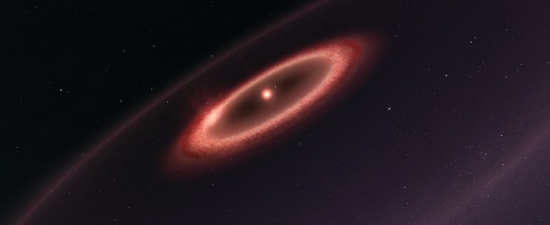
Image: Artist’s impression of dust belts around Proxima Centauri. Discovered in data from the Atacama Large Millimeter/submillimeter Array (ALMA) in Chile, the cold dust appears to be in a region between one to four times as far from Proxima Centauri as the Earth is from the Sun. The data also hint at the presence of an even cooler outer dust belt and may indicate the presence of an elaborate planetary system. These structures are similar to the much larger belts in the Solar System and are also expected to be made from particles of rock and ice that failed to form planets. Such belts may also prove useful in helping us investigate the presence of a possible second planet around this star. Credit: ESO / M. Kornmesser.
But Gaia astrometry is also crucial, for there is some evidence of an anomaly in Proxima’s tangential velocity that, if confirmed, would be compatible with the existence of a planet with a mass in the 10 to 20 Earth range, and a distance between 1 and 2 AU. Further work with Gaia data is clearly in the cards:
Given the target brightness and the expected minimum size of the astrometric signature…, Gaia alone should clearly detect the astrometric signal of the candidate planet at the end of the 5-year nominal mission, all the more so in case of a true inclination angle significantly less than 90°. Proxima is one of the very few stars in the Sun’s backyard for which Gaia alone might be sensitive to an intermediate separation planetary companion in the super-Earth mass regime.
A final consideration is that while the flux contrast between the hypothetical Proxima c and the parent star (depending on albedo, among other things) is beyond the capabilities of our current direct imaging technologies, the apparent separation of planet and star should be accessible to future high-contrast imaging instruments, perhaps the European Extremely Large Telescope, which the paper mentions along with other ground- and space-based instruments. So we have what the authors describe as ‘a very challenging target,’ but one with huge interest for astronomers continuing to characterize this closest of all stellar systems.
It seems premature to get too far into a discussion of how Proxima c formed, since we have yet to confirm it. However, the authors make the case that if it is there, this planet would challenge us to explain how it formed so far beyond the snowline, where super-Earths could take advantage of the accumulation of ices. Perhaps the protoplanetary disk here was warmer than we’ve assumed. In any case, the apparent circularity of the orbit and the absence of more massive planets closer in makes migration from the inner system unlikely. And I think we should leave formation issues there while we await new work, especially the authors note, from ALMA.
The Damasso paper reanalyzing the Proxima Centauri radial velocity data in 2017 is “Proxima Centauri reloaded: Unravelling the stellar noise in radial velocities,” Astronomy & Astrophysics 599, A126 (2017) (abstract/ preprint). The new Damasso et al. paper is “A low-mass planet candidate orbiting Proxima Centauri at a distance of 1.5 AU,’ Science Advances Vol. 6, No. 3 (15 January 2020). Full text.

.
New Planets from Old Data
We rightly celebrate exoplanet discoveries from dedicated space missions like TESS (Transiting Exoplanet Survey Satellite), watching the work go from initial concept to first light in space and early results. But let’s not forget the growing usefulness of older data, tapped and analyzed in new ways to reveal hidden gems. Thus recent work out of the Carnegie Institution for Science, where Fabo Feng and Paul Butler have mined the archives of the Ultraviolet and Visual Echelle Spectrograph survey of 33 nearby red dwarf stars, a project operational from 2000 to 2007.
The duo have uncovered five newly discovered exoplanets and eight more candidates, all found orbiting nearby red dwarf stars. Two of these are conceivably in the habitable zone, putting nearby stars GJ180 and GJ229A into position as potential targets for next-generation instruments. Both of these stars host super-Earths (7.5 and 7.9 times the mass of Earth), with orbital periods of 106 and 122 days respectively. Like the other planets unveiled in the discovery paper in The Astrophysical Journal Supplement Series, these worlds were all found using radial velocity methods, uniquely powerful when deployed on low-mass red dwarfs.
Temperate super-Earths are interesting in their own right, but one of these has a particular claim to our attention, as lead author Feng explains:
“Many planets that orbit red dwarfs in the habitable zone are tidally locked, meaning that the period at which they spin around their axes is the same as the period at which they orbit their host star. This is similar to how our Moon is tidally locked to Earth, meaning that we only ever see one side of it from here. As a result, these exoplanets [have] a very cold permanent night on one side and very hot permanent day on the other—not good for habitability. GJ180d is the nearest temperate super-Earth to us that is not tidally locked to its star, which probably boosts its likelihood of being able to host and sustain life.”
But GJ229Ac is also intriguing, a possibly temperate super-Earth in a system where the host star has a brown dwarf companion. That object, GJ229B, was one of the first brown dwarfs to be imaged, making this system an interesting testbed for planet formation models. We also have a Neptune-class planet orbiting GJ433 well out of the habitable zone, far enough from its star that the authors see it as a realistic candidate for future direct imaging. The planet is the coldest Neptune-like world we’ve yet found around another star, and also the nearest to Earth.

Image: Artist’s concept of GJ229Ac, the nearest temperate super-Earth to us that is in a system in which the host star has a brown dwarf companion. Credit: Robin Dienel, courtesy of the Carnegie Institution for Science.
Efforts like this don’t stop with a single dataset, but rely on multiple follow-ups to increase the fidelity of the data. Thus Feng and Butler used the Planet Finder Spectrograph at Las Campanas (Chile), ESO’s HARPS spectrograph (High Accuracy Radial Velocity Planet Searcher) at La Silla, and HIRES (High Resolution Echelle Spectrometer) at the Keck Observatory in a combination that, in Butler’s words, “increases the number of observations and the time baseline, and minimizes instrumental biases.”
I think Feng and Butler are right to emphasize the utility of the UVES data. From the paper:
The most important observation in a precision velocity data set is the first observation because observers cannot go back in time. For most of the stars in the UVES M Dwarf program, these are the first observations taken with state-of-the-art precision. This data set is all the more remarkable for focusing on some [of] the nearest stars, and the stars most likely to harbor detectable potentially habitable planets. These observations will continue to be important in finding and constraining planets around these stars for decades to come. We do not expect this to be the final word on this remarkable data set. We look forward to future researchers reanalyzing this data set with a superior Doppler reduction package, and producing the surprises that emerge from better measurement precision.
All of which emphasizes how creative we are learning to be with the data that in recent decades have been cascading in quantity, quality and importance. Nice work by the UVES M Dwarf team. As the paper goes on to say: “Starting back in the infancy of precision velocity measurements, they boldly went straight to the heart of the most interesting and challenging problem, finding potentially habitable planets around the nearest stars.”

And kudos to Feng and Butler for dedicating their paper to Carnegie astronomer and system manager Sandy Keiser, who died suddenly in 2017 during the analysis of the data from which these results emerged, but not before she produced work critical to this paper.
The paper is Butler et al., “A Reanalysis of the UVES M Dwarf Planet Search Program,” Astronomical Journal Vol. 158, No. 6 (2 December 2019). Abstract.

A Satellite for Eurybates
3548 Eurybates is a Jupiter trojan, one of the family of objects that have moved within the Lagrange points around Jupiter for billions of years (the term is libration, meaning these asteroids actually oscillate around the Lagrange points). Consider them trapped objects, of consequence because they have so much to tell us about the early Solar System. The Lucy mission aims to visit both populations (the ‘Greeks’ and the ‘Trojans’) at Jupiter’s L4 and L5 Lagrangians when it heads for Jupiter following launch in 2021.

Image: During the course of its mission, Lucy will fly by six Jupiter Trojans. This time-lapsed animation shows the movements of the inner planets (Mercury, brown; Venus, white; Earth, blue; Mars, red), Jupiter (orange), and the two Trojan swarms (green) during the course of the Lucy mission. Credit: Astronomical Institute of CAS/Petr Scheirich (used with permission).
Right now the focus is on Eurybates as mission planning continues, for we’ve just learned thanks to the Hubble instrument’s Wide Field Camera 3 that this asteroid has a moon, an object more than 6,000 times fainter than Eurybates itself. According to mission principal investigator Hal Levison (Southwest Research Institute), that implies a diameter of less than 1 kilometer. The tiny moon will be among the smallest asteroids visited by Lucy, which is intended to perform flybys of six trojans, as well as a main belt asteroid along the way.
Thomas Statler is a Lucy program scientist at NASA headquarters in Washington:
“There are only a handful of known Trojan asteroids with satellites, and the presence of a satellite is particularly interesting for Eurybates. It’s the largest member of the only confirmed Trojan collisional family – roughly 100 asteroids all traceable to, and probably fragments from, the same collision.”
It took three tries with Hubble to confirm the satellite’s existence, a tricky job given the object’s faintness and unknown orbit around the much brighter Eurybates. Now the task is to figure out when it will become visible again, for Eurybates won’t be observable until well clear of the Sun, which won’t happen until June. No major changes to the existing flight planning are needed to incorporate the small moon into the mission, but refining its orbit around the asteroid will help scientists schedule the best observing time during the Eurybates encounter.
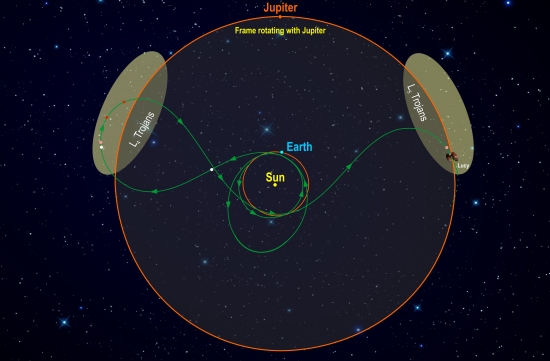
Image: This diagram illustrates Lucy’s orbital path. The spacecraft’s path (green) is shown in a frame of reference where Jupiter remains stationary, giving the trajectory its pretzel-like shape. After launch in October 2021, Lucy has two close Earth flybys before encountering its Trojan targets. In the L4 cloud Lucy will fly by (3548) Eurybates (white), (15094) Polymele (pink), (11351) Leucus (red), and (21900) Orus (red) from 2027-2028. After diving past Earth again Lucy will visit the L5 cloud and encounter the (617) Patroclus-Menoetius binary (pink) in 2033. As a bonus, in 2025 on the way to the L4, Lucy flies by a small Main Belt asteroid, (52246) Donaldjohanson (white), named for the discoverer of the Lucy fossil. After flying by the Patroclus-Menoetius binary in 2033, Lucy will continue cycling between the two Trojan clouds every six years. Credit: Southwest Research Institute.
We already have one binary to look forward to, for Patroclus, in the L5 cloud, has a small satellite called Menoetius. Note how stuffed with interesting things these Lagrangian points seem to be. We have D-type asteroids like Patroclus, which likely have water ice in the interior, as well as C- and P- class asteroids, the latter darker and bearing more similarities to Kuiper Belt objects than main belt asteroids. All are thought to be rich in volatiles. Our explorations here should offer insights into primordial planet-building materials in the early Solar System.


